by Guest Writer
From time to time, we here at Outdoor Design Group like to hand over the reins of this blog to a guest writer. This allows us to peer over the fence into the realm of another business, and bring our readers new views on topics related to our field of work.
This week, T.J. Wood from Plan-It Geo (a company that Outdoor Design Group has collaborated with in the past on various projects) gives us a description of an application they developed for the Colorado State Forest Service. This online tool helps Colorado communities assess their public street and park trees locally to provide a statewide picture of tree diversity and health.
Introduction:
At Plan-It Geo, we specialize in “Trees and Technology.” A tree inventory combines both of these elements seamlessly by management of this important natural resource with use of mobile devices and technology in the field. The Colorado State Forest Service contracted Plan-It Geo to develop a web-based application that communities, campuses, and HOA’s can upload their tree inventories and view important state-wide tree data summaries. To access all of our web and mobile GIS software applications, click here.
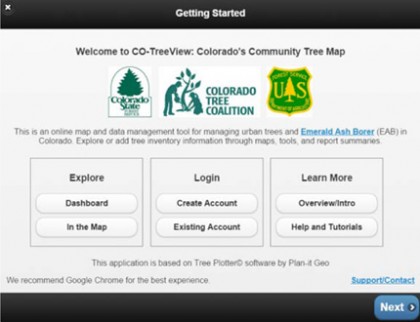
A screen shot from CO-Tree View
Colorado Tree View:
Project Profile: Colorado Tree View
Project Title: Colorado Tree View – Statewide Inventory and Ash management Application
Client: Colorado State Forest Service
Timeframe: February 2015 – Present
Description: Tree inventories provide critical information for cities, neighborhood associations, and other entities to proactively manage their urban and community forestry resource. This project provided a tool to help diversify the planning and planting of tree species. It also provided a first-time statewide view of the structure of Colorado’s urban forests. The tool is a starting point for a long-term strategy and provides substantial new technical support to communities.
Outcomes: A statewide web-based application was created for Colorado. This application has the built-in ability to “crosswalk” a wide variety of inventory data into the application. The main fields collected are species, dbh (diameter breast height), condition, and location of each tree. The application has a hierarchy of log ins based on city and user approvals with different functionality at each level. A customized dashboard was created for the state to view important number and population statistics on each community or organizational inventory.
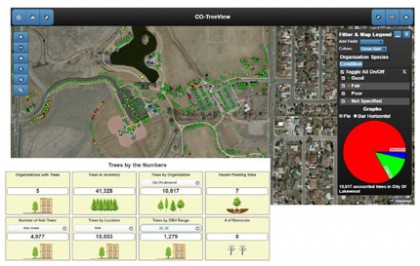
A screen shot from CO-Tree View
This is the official blog of Outdoor Design Group, Colorado Landscape Architects. For more information about our business and our services, click here.
Related Posts:
by Matt Corrion
While visiting a project site last week I noticed a mistake in landscape design that I had to share:
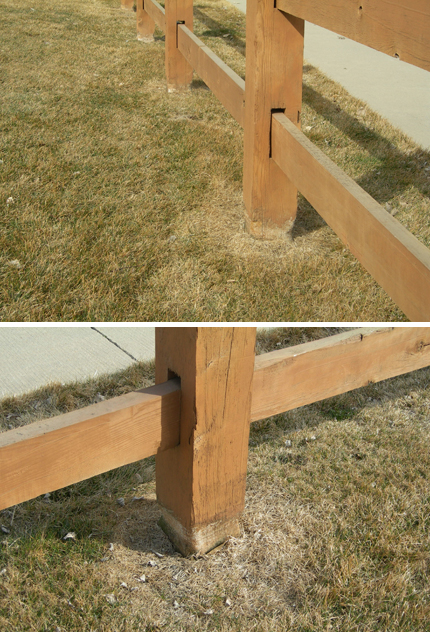
In our landscape plans we always prefer to place fencing out of lawn areas and within landscape beds, or at least in a strip of rock. In the photos above, these nice 6″x6″ posts are being slowly whittled away by trimmers, commonly known as “weed wackers”.
This is a condo project that was only built about 10 years ago. I don’t blame the maintenance crews, I blame a poor landscape design.
If anything, the maintenance crews are probably cursing the landscape architect- because they have to trim around about 80 of these posts every week.
Since lawn was designed around the fence (rather than placing the fence in a strip of rock), it also gets over-sprayed by the lawn irrigation, which not only wastes water, but will quickly deteriorate a wood fence. That’s probably why it looks like it recently had to be re-stained.
This is the official blog of Outdoor Design Group, Colorado Landscape Architects. For more information about our business and our services, click here.
Related Posts:
by Todd Rutherford
Who doesn’t love seeing the golden glow of aspen leaves (Populus tremuloides) dancing in the breeze on a mountain hillside? Many gardeners living at Colorado’s lower elevations have been smitten by the quaking leaves of aspen trees and tried to bring some of that mountain magic into their own yard. But doing so reveals lessons in plant ecology, and reminds us that not every plant we want to have in our home landscapes can easily grow there.
Aspens are a “succession” tree, moving into areas where other trees and shrubs were removed by logging, fire, erosion, insects or disease. As a succession species, they are not long lived. Their presence helps lead the way to other longer living trees.
In addition, aspens are highly susceptible to insect damages and diseases. Aspens that were collected in the wild are even more prone to damage and disease, as their root system is either injured or is incomplete during collection. Nursery grown aspens are generally healthier than collected ones, but still will likely succumb to problems and a shortened life.
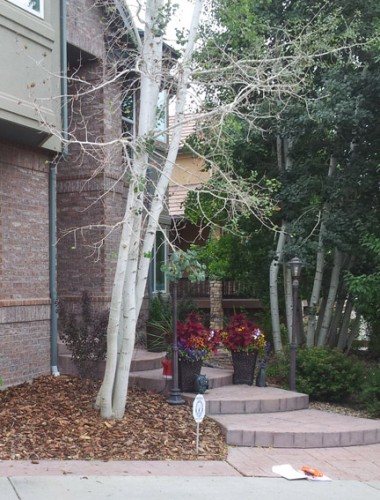
A diseased aspen tree.
Most arborists and horticulturists advise against planting Aspens along the Colorado’s Front Range. The growing conditions of the Front Range are different than those areas where Aspen thrive naturally. Aspens like to grow in gravelly, moist but well-drained soil with a lower pH (more acidic) that can typically be found at higher elevations. Along Colorado’s Front Range, our soils are typically heavy clay soils that don’t drain well and have a higher pH (more alkaline). Summer weather along the Front Range is hotter and drier than in the mountains, another factor going against the health of Aspens planted east of the high country.
If you really must have the quaking leaves of aspen in your yard, only plant them if you can place them in the north or east sides of your home (due to the afternoon heat of south and west exposures) and only if it is a nursery grown tree. Keep them away from objects that might radiate too much heat to the trees such as paving. Amend the soil with organic matter in an attempt to increase the acidity of the soil, and then mulch the newly planted tree well. You might also consider adding gravel or perlite to the soil before you plant to improve drainage, and reduce the problem of heavy clay soil.
Even if you can adhere to the aforementioned criteria while planting your aspen, it’s not likely your tree will achieve the brilliant gold of the aspens at higher elevations due to differences in soil chemistry, soil texture, soil moisture, day and night temperatures, and sunlight discrepancies at the different elevations. In addition you should be on the lookout for several different diseases and insects that more readily afflict aspens planted out of their native range.
Furthermore, if you want to remove aspen trees that are established in your yard, you may get many suckers (the stems that sprout up from aspen roots) coming up in your yard for many months after you removed the main trunk.
So in my opinion, no, aspen trees should not be planted in the Denver area, because it is not likely they will do well. But if you are aware of the many shortcomings of aspens planted outside of their native range, feel free to give them a try.
This is the official blog of Outdoor Design Group, Colorado Landscape Architects. For more information about our business and our services, click here.
Related Posts:
by Todd Rutherford
As gardeners in Colorado may well know, our climate and altitude make for challenging growing conditions. This doesn’t mean we are completely immune from invasive exotic plants making an unwelcome home here. We do not have the burden that gardeners in wetter and warmer states may have at stopping the spread of invasive plants, but there are a few species you should be aware of so you can help stop these unwanted guests from gaining a foothold in our landscapes.
Why be concerned about invasive plants? They crowd out native plants, propagate uncontrollably, and may reduce forage for wildlife. Some may have a negative impact on your garden plants. And research suggests that some invasive species may pose dangers to humans through the increased risk of flooding due to damaged waterways, or increased fire danger.
The two worst invasive woody plants for Colorado and the surrounding region are the Russian Olive and the Tamarisk. Russian Olive (Elaeagnus angustifolia), is native to western and central Asia. It was introduced into North America in the latter part of the 1800’s. It is not related to true olive plants (Olea europaea) but its fruit is edible but not very palatable for human consumption. It out competes native plants because its seeds are irresistible to birds which spread the seeds far and wide. The seeds have a low mortality rate, germinate readily in poor soil (it can fix its own nitrogen in its roots), reach maturity quickly and thus outcompete native plants. In Colorado, they often begin setting a foothold in riparian areas, and then spread from there.
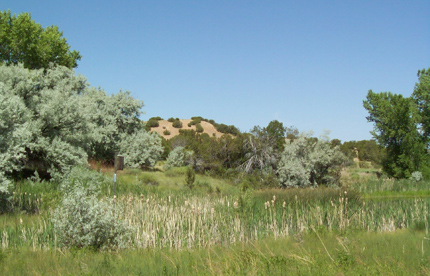
Russian Olives invading a wetland in New Mexico.
Tamarisk (Tamarix ramosissima), which is more of a shrub than a tree, similarly starts its spread in the riparian areas of the Colorado and other southwestern states. It has been such a successful invader of wet areas, that it has overtaken huge sections of the rivers of the southwest. However, it is not as tolerant of cold temperatures as is Russian Olive, which restricts its spread to the warmer, lower elevations of the southwest. Tamarisk is tolerant of many soil types, and thrives in full sun. One of the concerns about Tamarisk’s effect on native landscapes is how they out compete native vegetation, altering the nutrient cycles of riparian areas. They also consume large amounts of water, and secrete large amounts of salt, both items further slowing the success of nearby native plants. A massive amount of resources and manpower are being directed at the fight to stop the spread of this plant through the wildlands of the desert southwest.
…the Siberian Elm is “one of, if not the, world’s worst trees…a poor ornamental that does not deserve to be planted anywhere”.
Closer to Denver and the urban areas of Colorado’s front range, there are two trees that are common pests. These are the Siberian Elm (Ulmus pumila), and the Tree of Heaven (Ailanthus altissima). Both of these trees release a profuse amount of seeds, and these seeds are very adept at sprouting in disturbed areas. They proliferate along transportation corridors and abandoned lots. Both trees prefer full sun, but Ailanthus can tolerate some shade allowing it to invade some mature native forests.
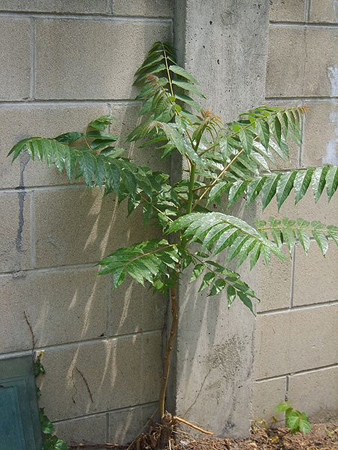
Young Ailanthus altissima
Although not directly related, Ailanthus trees (a.k.a. Tree of Heaven) are often mistaken as sumacs. In springtime they produce many flowers that have a foul odor which some say is similar to cat urine. It rapidly out competes other tree species, releasing an allelopathic chemical which inhibits the growth of other plants. Some researchers have extracted this chemical from Ailanthus trees, successfully using it as an herbicide. Not only is this tree toxic to other plants, there have been anecdotal reports of it being slightly toxic to humans and livestock. Ailanthus trees can grow quite rapidly, leading to weak, unstable branches.
Siberian Elms also have structural problems, with many weak or dead branches that can break off in heavy wind. Siberian elms have a short dormancy period which leads to early flowering in spring, and late leaf drop in fall. In Colorado that means they can become dangerously loaded with wet snow in our common heavy spring snowstorms, or the occasional fall snowstorm, leading to heavy branches falling on roofs and vehicles. In addition to the dangers of breaking limbs, the trees do not have a very favorable appearance, with an awkward branching pattern. One doesn’t need to search too long before you find many Siberian elm seedlings sprouting up in unwanted spots in the urban landscape. The sprouts show up in shrub beds where they are difficult to remove by hand and hard to spray with herbicides without damaging neighboring desired plant materials. Siberian elms are susceptible to damage from elm leaf beetles which leave the leaves looking skeletonized, but it doesn’t seem to kill the trees. Notable horticulturalist Michael Dirr says the Siberian Elm is “one of, if not the, world’s worst trees…a poor ornamental that does not deserve to be planted anywhere”.
To be fair, I should mention that some people look favorably upon these four tree species, and say that in Colorado’s high desert climate (that is naturally and predominantly tree-less east of the Rocky Mountains), an invasive tree is better than no tree, especially in urban areas. I would beg to differ, noting that these trees are too difficult to control and remove, to the detriment of native flora and fauna. Please become aware of these invasive trees and be considerate about whether you want to allow these in your landscape.
This is the official blog of Outdoor Design Group, Colorado Landscape Architects. For more information about our business and our services, click here.
Related Posts:
by Todd Rutherford
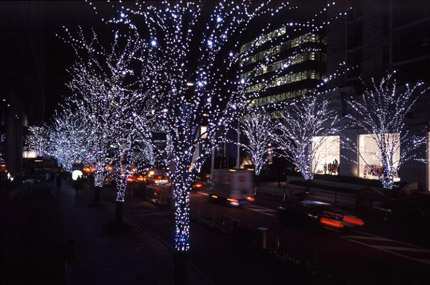
If you’ve not purchased holiday lights in several years, you are in for some surprises next time you head out shopping for new holiday lighting. Recent advances have produced a wave of new and innovative LED lighting that is far more energy efficient than holiday lighting your father or grandfather installed in years past. Many of the new LED holiday light strings are 7 to 8 times more efficient than traditional incandescent light strings. This translates to additional benefits aside from lowered electricity bills: more strings can be safely strung together end-to-end (which may mean a simplified layout of your light display) and there is a lowered fire hazard as the strings do not get as hot as many of the incandescent holiday light bulbs.
One down side to these new types of holiday lights is their higher up-front cost. But if you calculate in the lower operating costs, LED lights are likely to cost you less money in the long run. And as more LED holiday lights are being manufactured, prices have been dropping.
One criticism of LED lights has been the tendency of light from LED bulbs to appear harsh and “cold”. Manufacturers have responded to this issue and are now producing LED holiday lighting that appears “warmer”, like the incandescent lights they are intended to replace.
So this year, consider adding some ‘green’ lights to your holiday decor by choosing energy efficient LED holiday lights.
Here’s a list of pros and cons for LED Holiday lighting:
PROS
Lower energy use / operating cost
Lower heat output (Less fire hazard)
Longer life
More strings can be connected safely (Fewer outlets or extension cords needed)
CONS
Higher purchase cost than incandescent.
Color & “temperature” of light output difference as compared to incandescent
This is the official blog of Outdoor Design Group, Colorado Landscape Architects. For more information about our business and our services, click here.
Related Posts:






